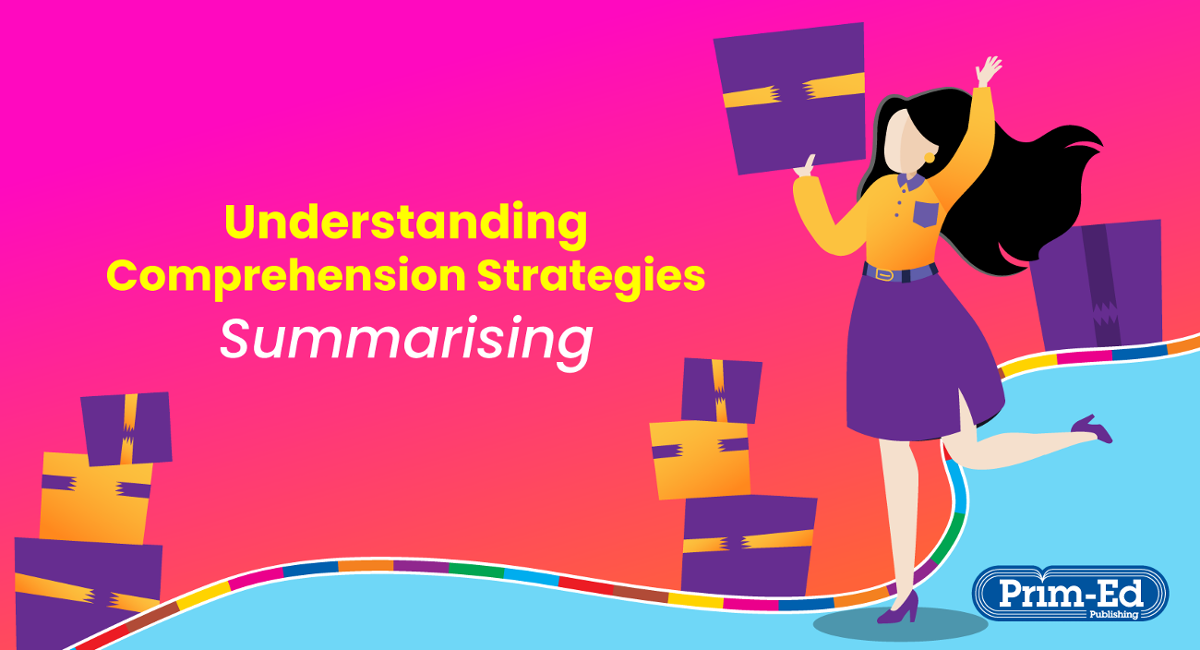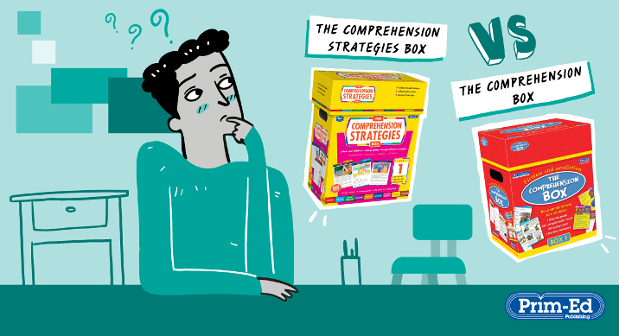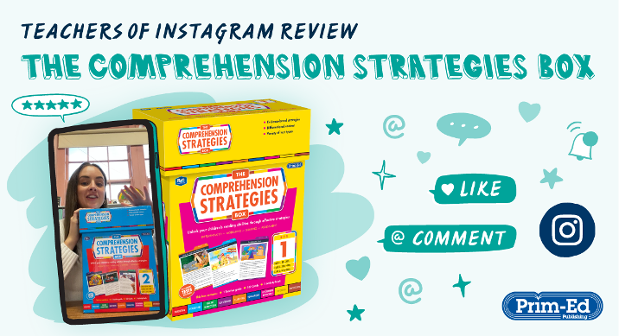- Wednesday 30 September 2020
Reading Comprehension Strategies – Summarising
The Summarising Reading Comprehension Strategy
Understanding what they read is one of the biggest difficulties a child will have while reading. It is therefore crucial that they are explicitly taught a range of strategies to encourage and master reading comprehension.
Summarising is recalling the main points or ideas of a text and how they relate to each other.
Summarising requires readers to sequence a text, retell a text using the vocabulary used in the text, put it into their own words (paraphrase) and, finally, select the most important ideas to sum up what the author has told them. This will enable them to have a more concise understanding of a text.
Summarising involves selecting the key words in a paragraph, locating the topic sentence (i.e. a sentence that contains the main message often found at the start or conclusion of a paragraph), articulating the idea of the sentence, and repeating this process until they have completed the text. As they get older and more skilled, children also need to learn how to identify and discard irrelevant information.
Knowledge of text structures can make it easier for readers to summarise a text because they can work out which parts of the text are important, and which are less important. They can then delete the supporting details from their summary.
Summarising in the Classroom
Summarising is not just a reading comprehension strategy. The ability to summarise is also an important life skill with many applications, in and out of the classroom. Teachers can utilise everyday classroom and personal experiences as summarising activities; for example, In 20 seconds or less, tell me what you did at lunchtime, or, In two sentences, explain what you learnt from the science experiment.
Teachers can develop children’s summarising skills and therefore comprehension using a variety of media and text types.
Provide a text or view a scene from a movie or TV show. Display some examples of good and bad summaries about the text or scene. These must be short and only include the most important ideas. Discuss each summary and decide which one is the most accurate and brief, and therefore the best one.
Read a recount text with the children and tell them they are going to write a newspaper report about it. The headline needs to sum up and capture the content of the recount, in just a few words. As a class, think of some suitable headlines that would summarise the recount.
Read a narrative text with the children. Create six cards with ‘who’, ‘what’, ‘where’, ‘when’, ‘how’ and ‘why’ written onto them. Show a child, or group of children, one of the cards. They think of a question that starts with this word for the rest of the class to answer. The class needs to answer the questions as succinctly as possible.
Provide a different text and read it through with the children. Look at each sentence and work out ‘who’ or ‘what’ the sentence is about. Then discuss what is the most important thing about the ‘who’ or ‘what’. Children should give ideas in their own words rather than repeat words straight from the text.
Progress to summarising short paragraphs, working out ‘who’ and ‘what’ each paragraph is about and what is the most important thing about the ‘who’ or ‘what’. Ensure children always give short summaries in their own words.
Provide short paragraphs and practise locating the topic sentence in each one. A topic sentence contains the main idea/message in a text and is often found at the beginning or conclusion of a paragraph.
Provide a new text and work through the following steps to create a short summary:
- Look for and list the key words and main ideas in each sentence or paragraph.
- Draw a line under the main idea statements and most important ideas in the text.
- Combine any ideas that can go into one sentence.
- Number the ideas in order.
- Write a summary in one or two sentences or one paragraph.
- Read through and edit the summary.
Templates could be used to help children record their summaries in an organised way. Children should be encouraged to look at a sentence and identify the key words, particularly ‘who’ or ‘what’ the sentence is about. Once children have a good grasp of this, they should do the same with paragraphs, and then summarise each paragraph into a short sentence, using their own words.
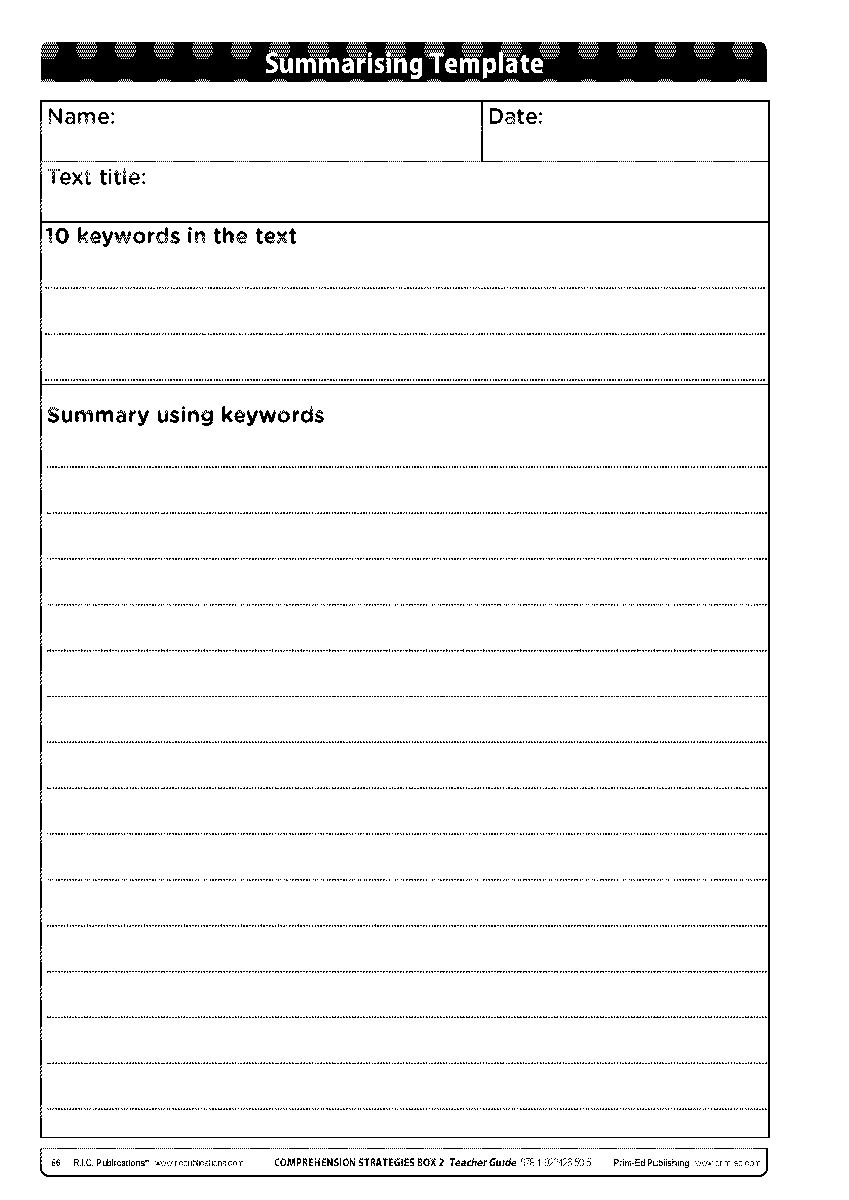
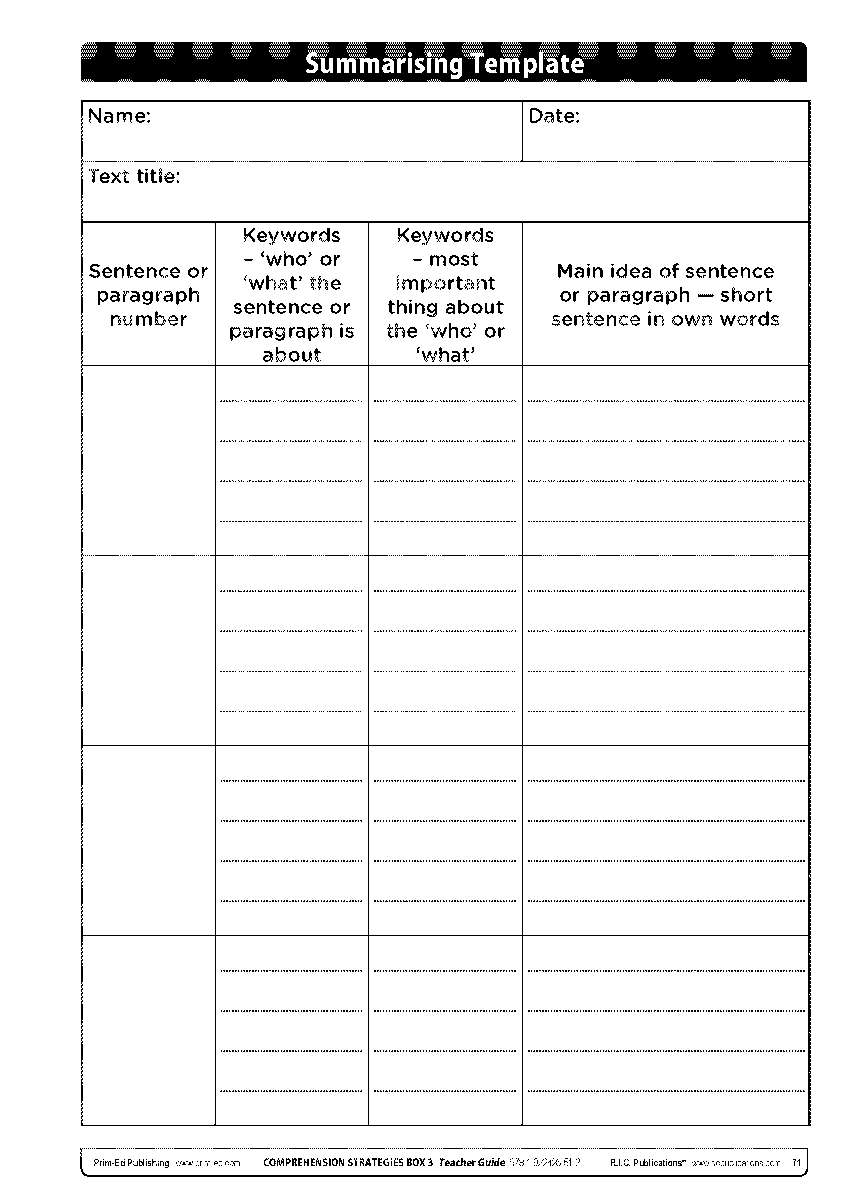
Templates from Teacher Guides in The Comprehension Strategies Box series.
Summarising in The Comprehension Strategies Box
Summarising is the sixth of nine reading comprehension strategies covered in the The Comprehension Strategies Box series. This boxed series, written at six levels for the six main primary school years, consists of full-colour, differentiated, fiction and non-fiction reading cards which cover nine different comprehension strategies, a comprehensive teacher guide that explains the strategies and how to use the series, and an activity book with photocopiable activities to enable children to focus on and practise each strategy.
Each reading strategy is introduced in the teacher guide, with a page of background information for teachers to familiarise themselves with.
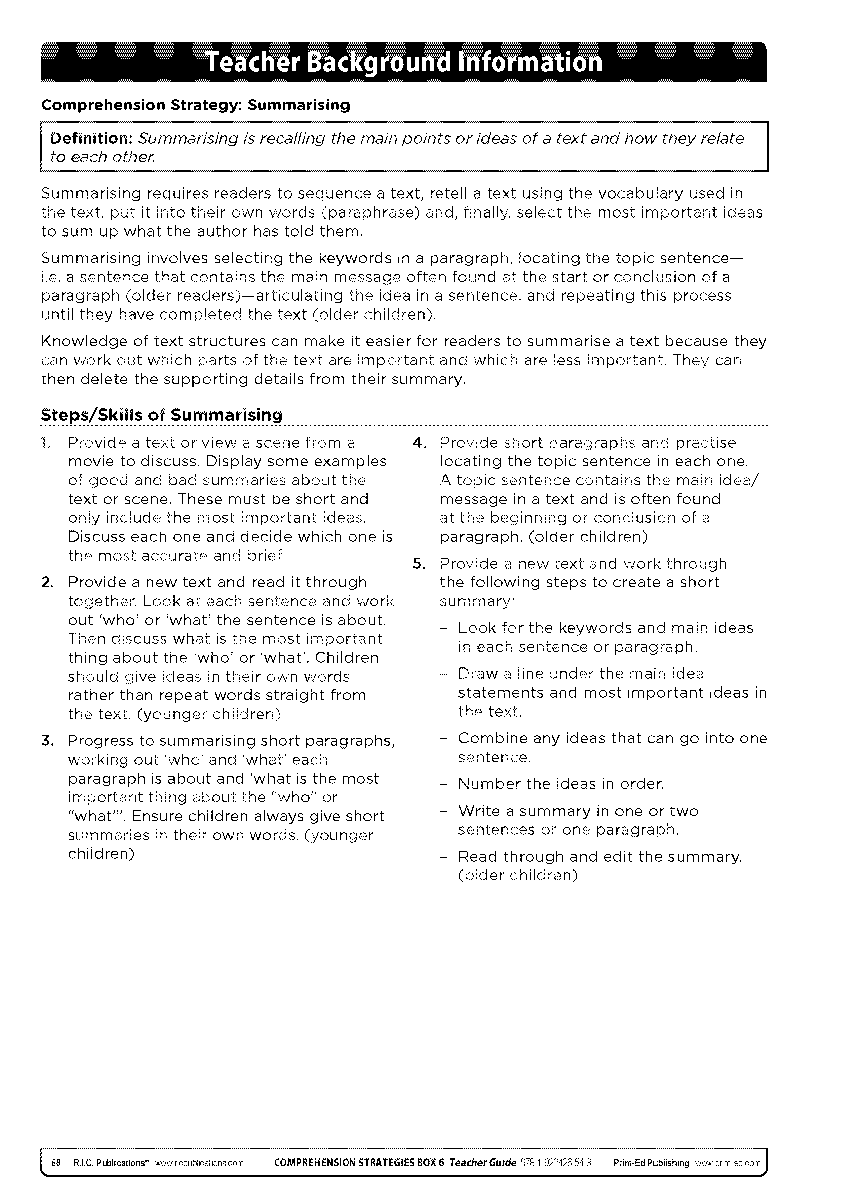
Sample page from Teacher Guide 6 in The Comprehension Strategies Box series.
The teacher should then use the modelling text provided to introduce and demonstrate the summarising comprehension strategy to their class. The illustrated text should be displayed onto an interactive whiteboard, to enable the teacher to conceal and reveal parts of the text to the children, and highlight text and add annotations as appropriate. The steps the teacher should go through to model and teach the strategy are clearly laid out in the teacher notes. The modelling is oral and starts by asking children to look at and discuss the illustration and title. The teacher should then provide the children with a selection of summaries. The children should be reminded that summaries must be brief and tell ‘who’ or ‘what’ the text is about, before they decide which ones are good summaries and which are not. The teacher should then read the text with the children, paragraph by paragraph. After each paragraph, the children should answer the questions succinctly and summarise the paragraph content in one sentence. At the end of the modelling session, the teacher should remind the children of the selection of summaries they discussed previously and decide which one is the best summary of the text. Finally, challenge the children to think of an even better summary.
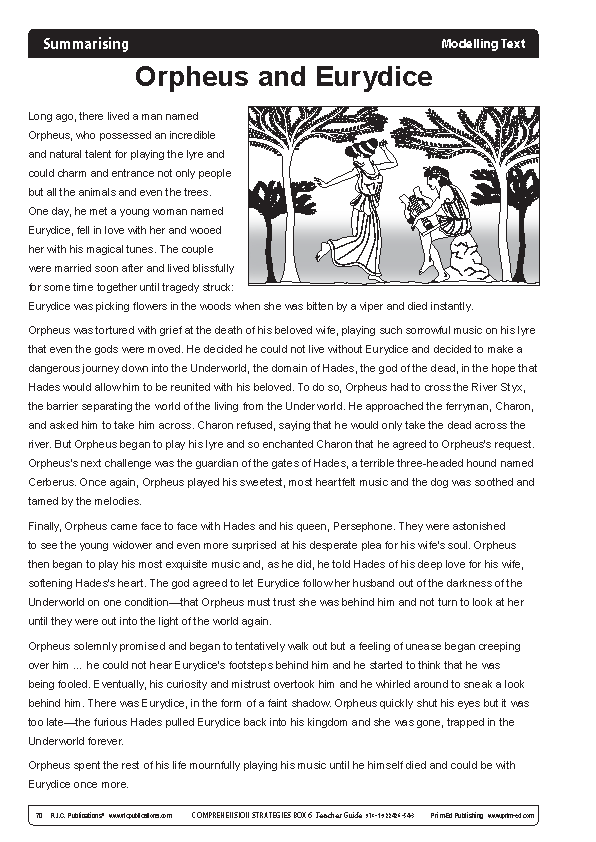
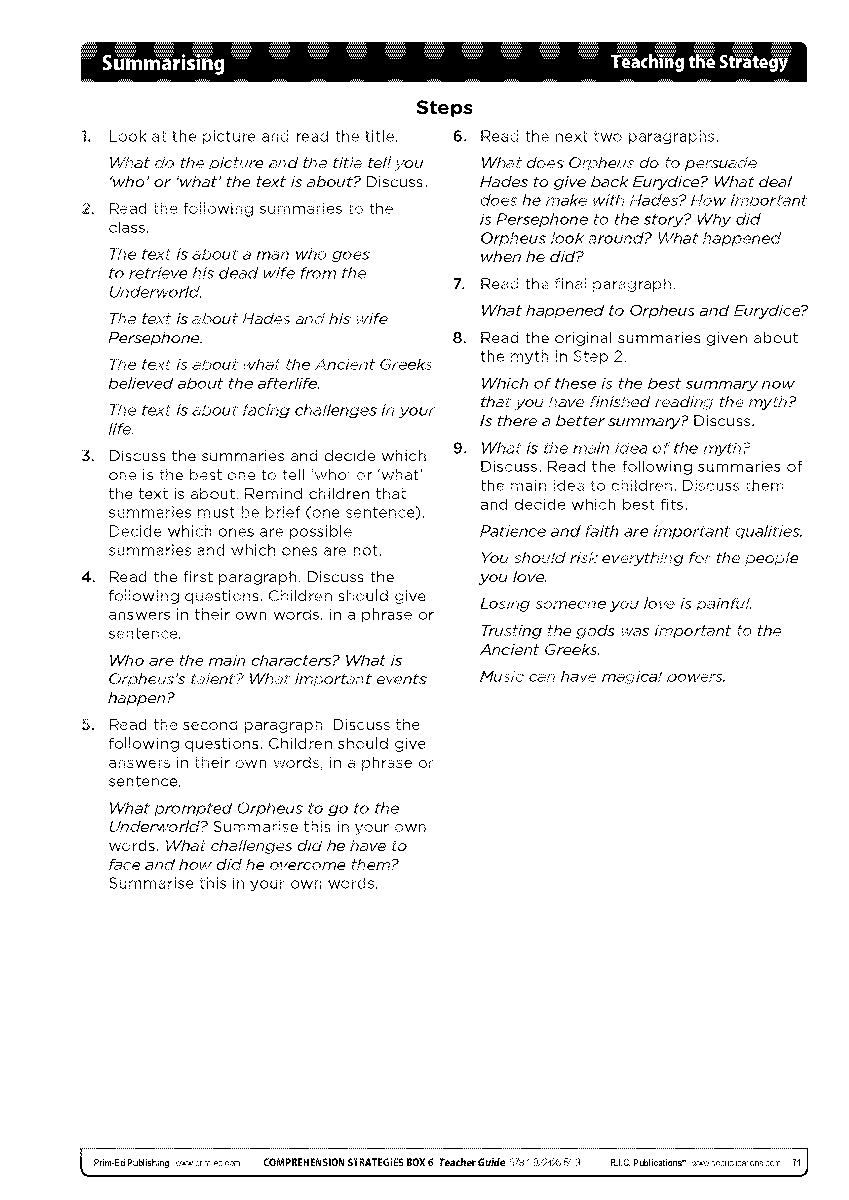
Sample pages from Teacher Guide 6 in The Comprehension Strategies Box series.
In a similar way to how the modelling text was presented and used with the class, the teacher should then present the sharing text. This can either be another oral activity or children may work with each other to answer the questions and practise the strategy together.
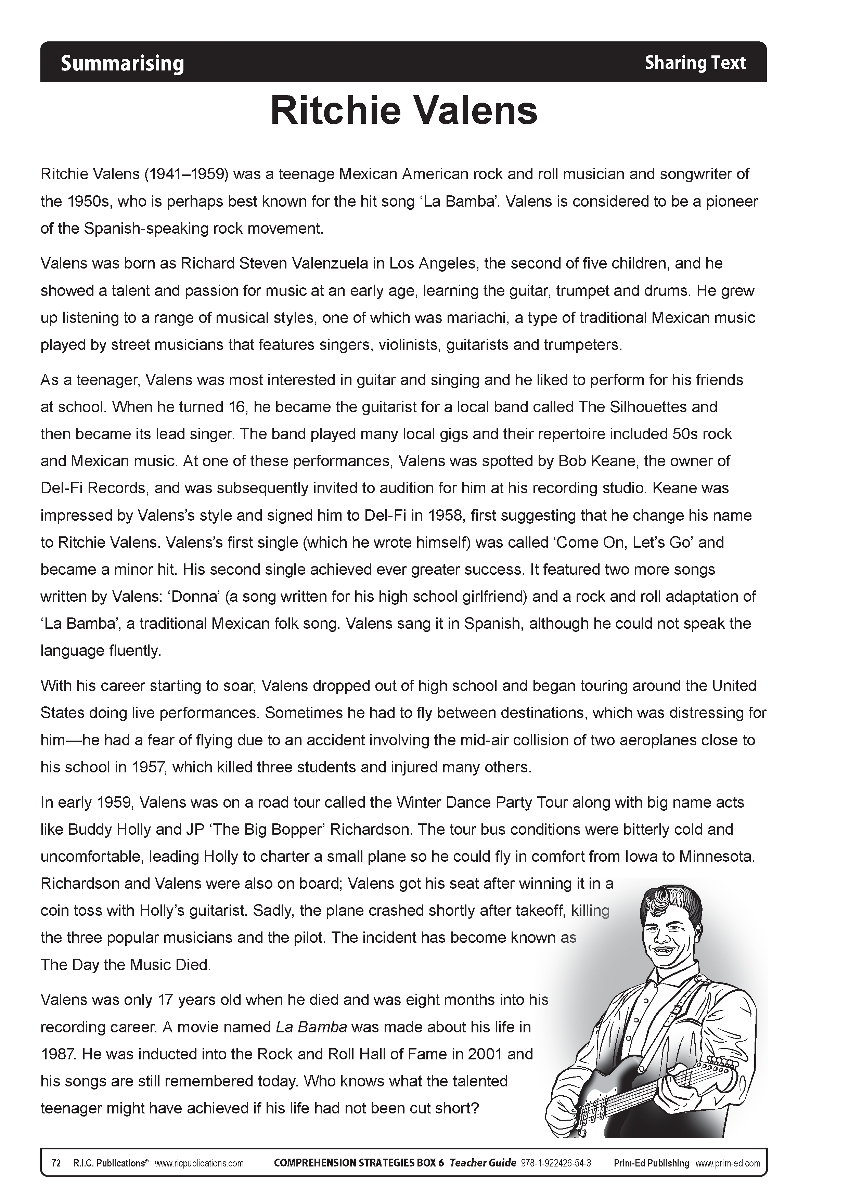
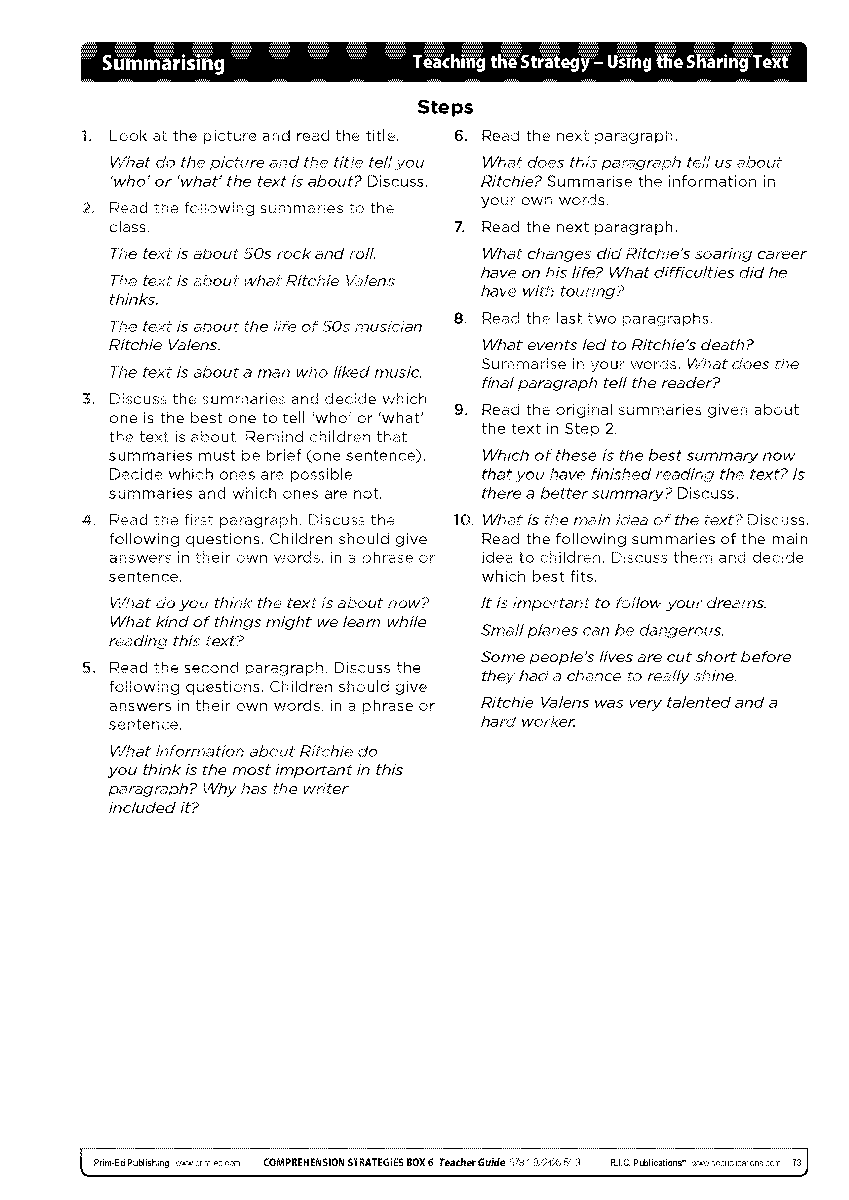
Sample pages from Teacher Guide 6 in The Comprehension Strategies Box series.
The children can then work on some of the activity cards, either individually, in pairs or in small groups. The teacher should select a particular level of card (1, 2 or 3), depending on the reading level of the child or group. A placement test is provided to help with this. There are two texts on each card, so children can practise the summarising strategy using more than one text. The children should use the corresponding resource sheets in the activity book which pose questions and activities that children will need to use summarising skills to answer.
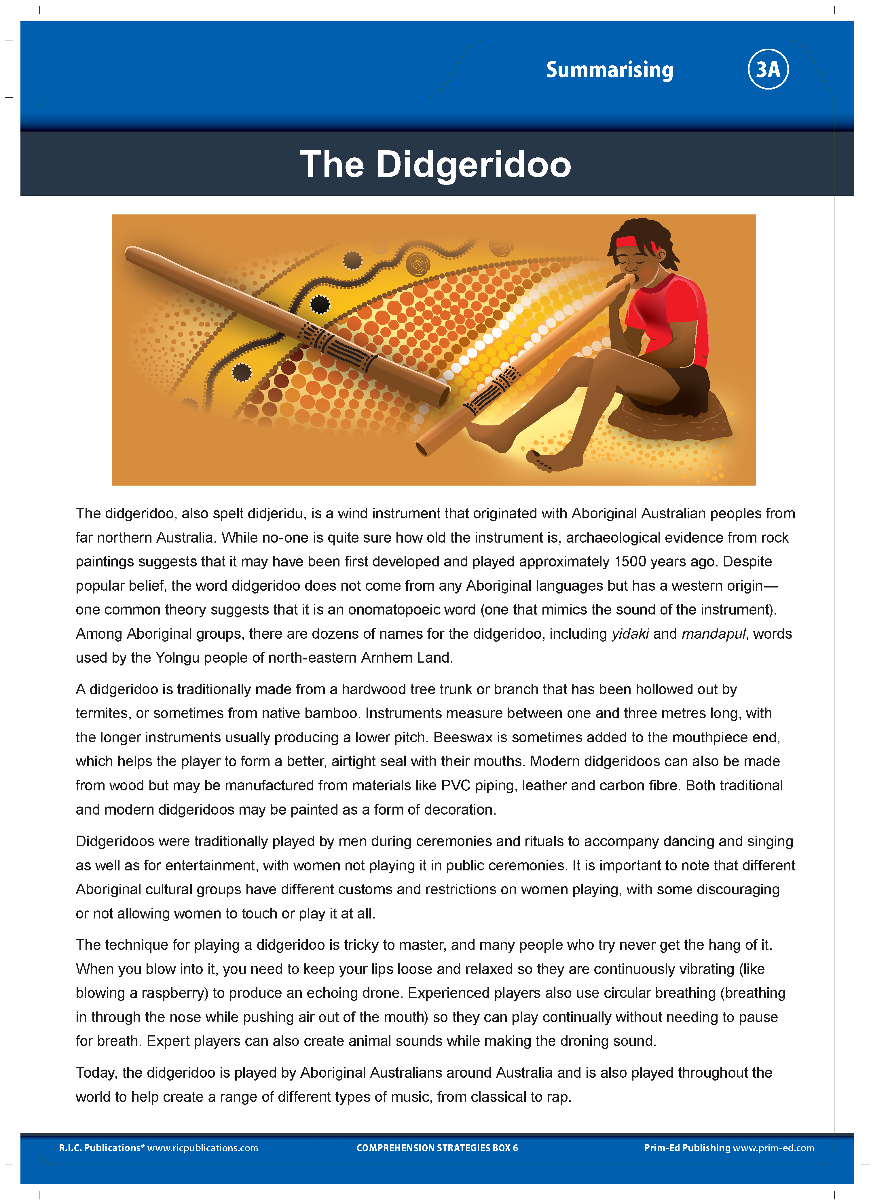
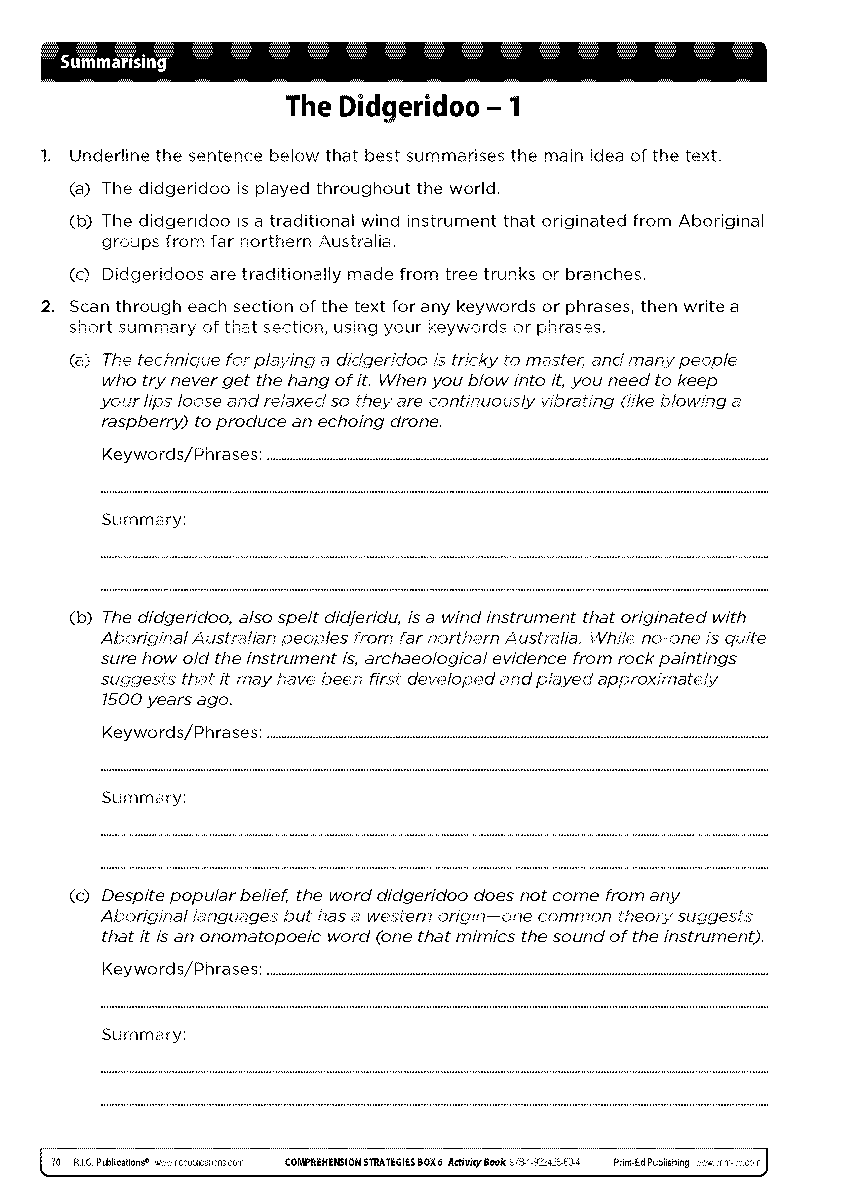
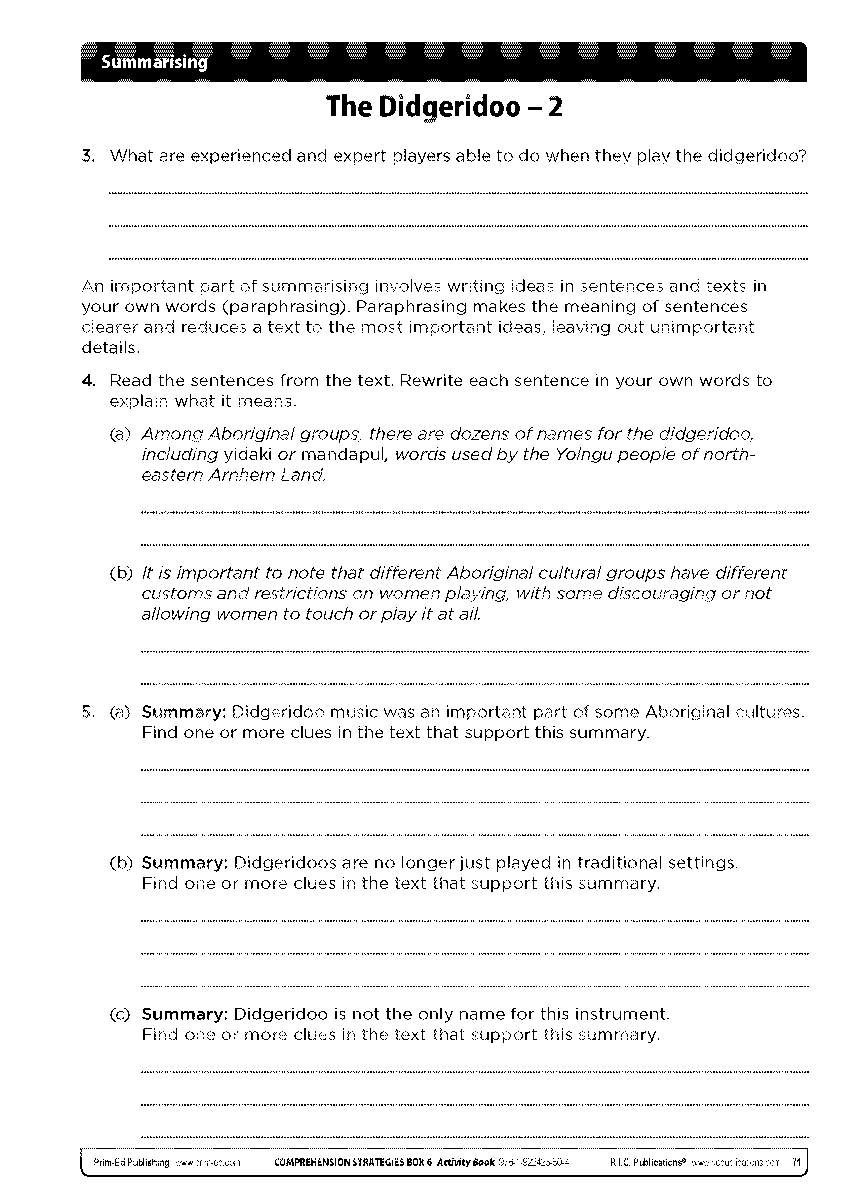
Card and sample pages from Activity Book in The Comprehension Strategies Box 6.
The teacher can use the assessment text in the teacher guide and the corresponding assessment questions to assess how well each child has understood and can use the summarising comprehension strategy.
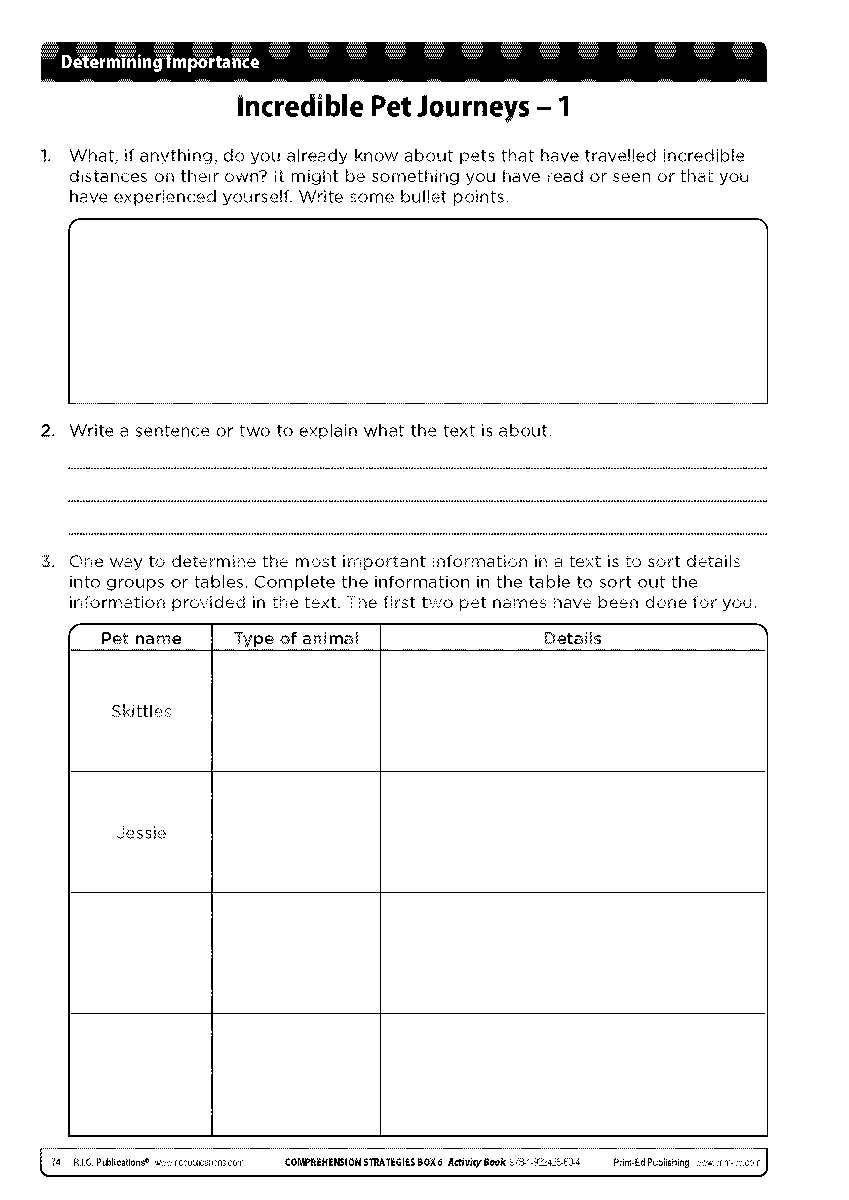
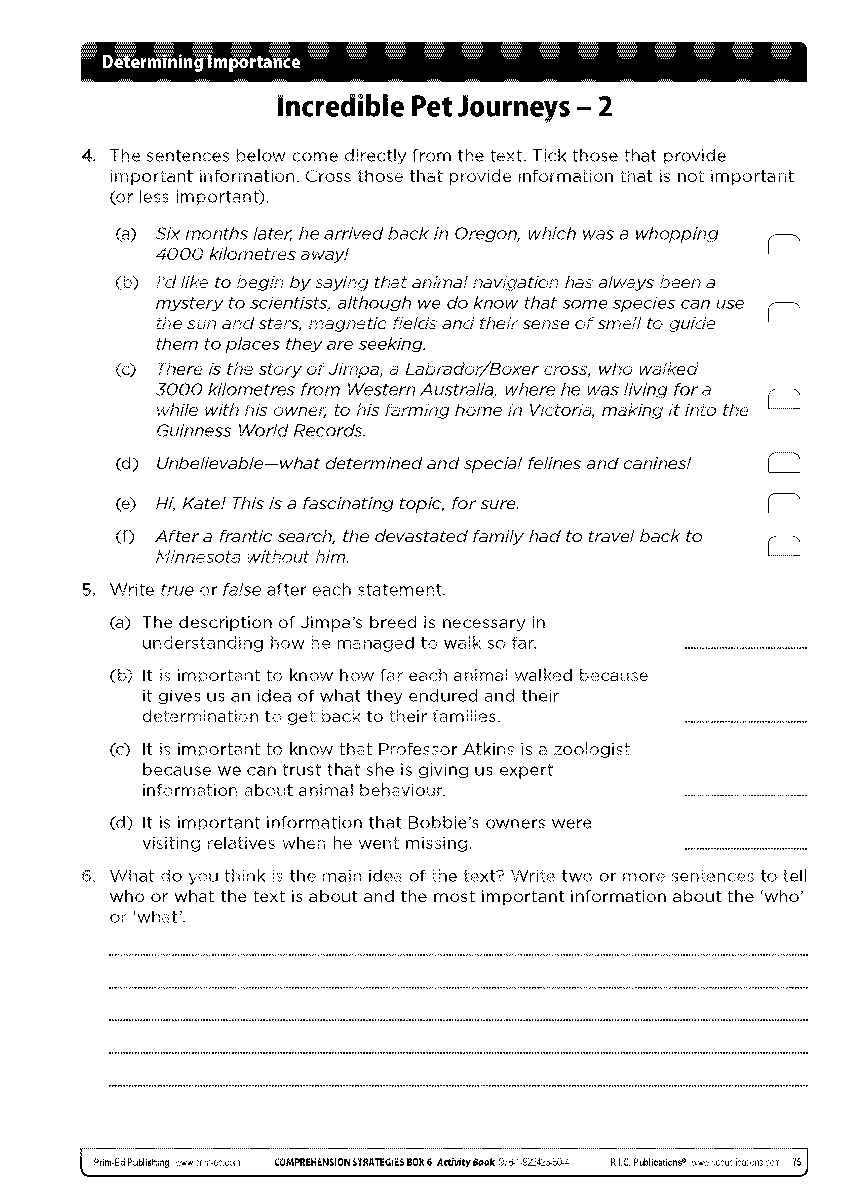
Sample pages from Teacher Guide 6 in The Comprehension Strategies Box series.
Other Resources to Teach the Summarising Strategy:
Besides The Comprehension Strategies Box, Prim-Ed Publishing also publishes a seven-book copymaster series, titled Teaching Comprehension Strategies, which uses modelling, discussion and guided and independent practice to teach children the strategies they can use to develop different reading skills.
